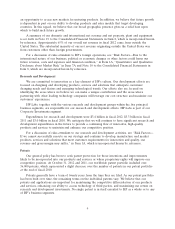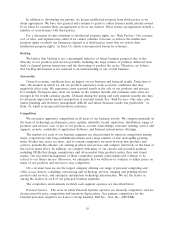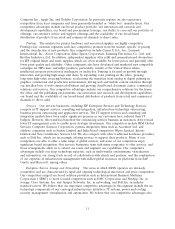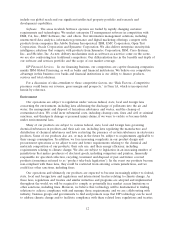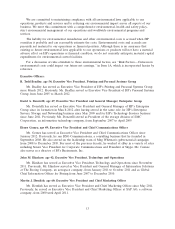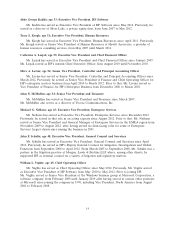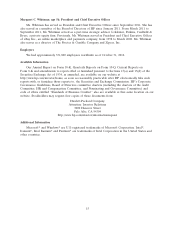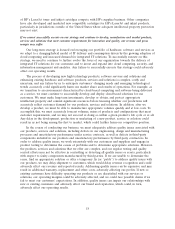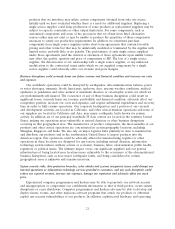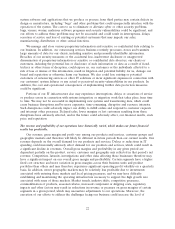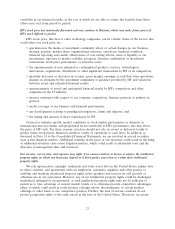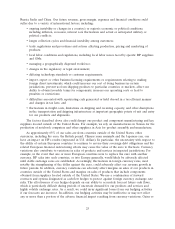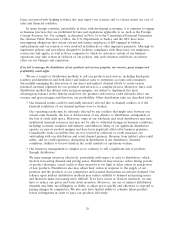HP 2012 Annual Report Download - page 24
Download and view the complete annual report
Please find page 24 of the 2012 HP annual report below. You can navigate through the pages in the report by either clicking on the pages listed below, or by using the keyword search tool below to find specific information within the annual report.ITEM 1A. Risk Factors.
Because of the following factors, as well as other variables affecting our operating results, past
financial performance may not be a reliable indicator of future performance, and historical trends
should not be used to anticipate results or trends in future periods.
If we are unsuccessful at addressing our business challenges, our business and results of operations may be
adversely affected and our ability to invest in and grow our business could be limited.
There are many challenges facing our business. Many of those challenges relate to structural and
execution issues, including the following: we need to align our costs with our revenue trajectory; we
need to address our underinvestment in R&D and in our internal IT systems in recent years, which has
made us less competitive, effective and efficient; we need to implement the data gathering and
reporting tools and systems needed to track and report on all key business performance metrics so as
to most effectively manage a company of our size, scale and diversity; and we need to rebuild our
business relationships with our channel partners. We are also facing dynamic market trends, such as the
growth of mobility, the increasing demand for hyperscale computing infrastructure, the shift to
software-as-a-service and the transition towards cloud computing, and we need to develop products and
services that position us to win in a very competitive marketplace. Furthermore, we face a series of
significant macroeconomic challenges, including broad-based weakness in consumer spending, weak
demand in the SMB and enterprise sectors in Europe, and declining growth in some emerging markets,
particularly China.
We are working to address these challenges. During fiscal 2012, we implemented some leadership
and organizational changes, including consolidating our personal computer and printing businesses
under the same senior executive leadership, merging our global accounts sales organization into ESSN,
and centralizing all of our marketing and communications activities. We also began implementing cost
reduction initiatives, including the company-wide restructuring plan discussed below. In addition, we
began making significant changes to our sales force to improve our go-to-market selling activities and
reduce cost, and we renewed our focus on developing new products, services and solutions. We also
began working to optimize our supply chain, reduce the number of stock keeping units (SKUs) and
platforms, refine our real estate strategy, improve our business processes and implement consistent
pricing and promotions. During fiscal 2013, we will be focused on working through the anticipated
disruptions expected to accompany the changes made in fiscal 2012 and continuing to implement our
cost reduction and operational initiatives. We may experience delays in the anticipated timing of
activities related to these efforts and higher than expected or unanticipated costs in implementing them.
In addition, we are vulnerable to increased risks associated with implementing these changes given our
large portfolio of businesses, the broad range of geographic regions in which we and our customers and
partners operate, and the number of acquisitions that we have completed in recent years. If we do not
succeed in these efforts, or if these efforts are more costly or time-consuming than expected, our
business and results of operations may be adversely affected, which could limit our ability to invest in
and grow our business.
In May 2012, we announced a company-wide restructuring plan expected to be implemented
through the end of fiscal 2014. The restructuring plan includes both voluntary early retirement
programs and non-voluntary workforce reductions and is expected to result in 29,000 employees exiting
the company by the end of that period. Significant risks associated with these actions and other
workforce management issues that may impair our ability to achieve anticipated cost reductions or that
may otherwise harm our business include delays in implementation of anticipated workforce reductions
in highly regulated locations outside of the United States, particularly in Europe and Asia, decreases in
employee morale and the failure to meet operational targets due to the loss of employees. In addition,
our ability to achieve the anticipated cost savings and other benefits from these actions within the
expected time frame is subject to many estimates and assumptions. These estimates and assumptions
16





